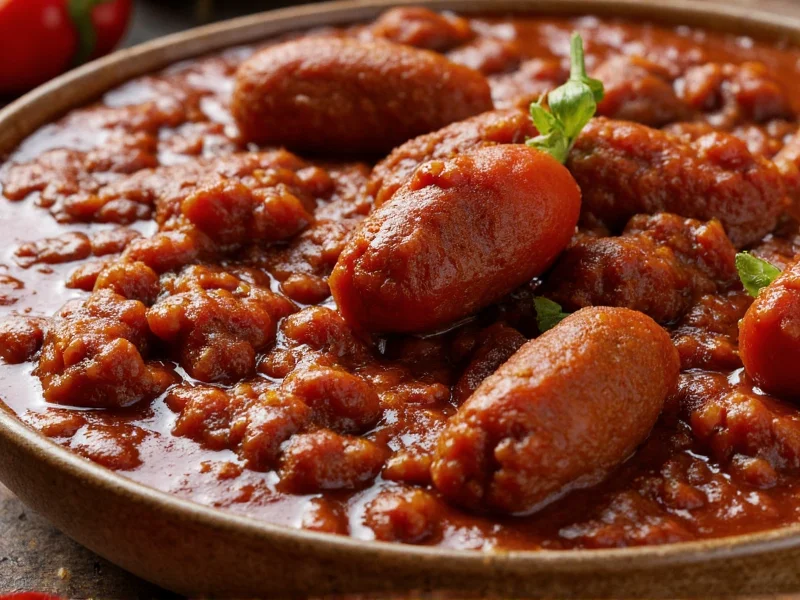When exploring Mexican cuisine, few sauces generate as much curiosity—and confusion—as mole. Many people wonder is mole spicy before trying it, often assuming all Mexican food carries significant heat. The reality is far more nuanced, with mole representing one of Mexico's most sophisticated culinary achievements that prioritizes flavor complexity over simple spiciness.
Understanding Mole: More Than Just Heat
Mole (pronounced moh-lay, not “mole” like the animal) refers to a family of sauces originating from Mexico, with the most famous being mole negro from Oaxaca. These sauces typically combine between 20-30 ingredients, creating complex flavor profiles that balance sweet, savory, earthy, and sometimes spicy elements.
The misconception that is traditional mole sauce spicy likely stems from the inclusion of chili peppers in many recipes. However, authentic mole preparation focuses on achieving harmony among ingredients rather than emphasizing heat. In fact, many traditional moles use toasted, ripe chilies that contribute deep flavor with minimal spiciness.
Mole Varieties and Their Spice Profiles
Mexico boasts at least seven major types of mole, each with distinct characteristics and varying heat levels:
| Mole Variety | Primary Region | Spice Level | Key Ingredients Affecting Heat |
|---|---|---|---|
| Mole Negro | Oaxaca | Mild to Moderate | Chilhuacle negro, mulato, pasilla (toasted) |
| Mole Rojo | Puebla | Moderate | Guajillo, ancho, pasilla chilies |
| Mole Coloradito | Oaxaca | Mild | Guajillo chilies (sweet varieties) |
| Mole Verde | Various | Variable | Tomatillo, pumpkin seeds, serrano peppers |
| Mole Amarillo | Oaxaca | Mild | Guajillo, pasilla, chipotle (used sparingly) |
What Determines Mole's Spiciness?
Several factors influence whether how spicy is authentic mole in any given preparation:
Chili Selection and Preparation
The specific chilies used and how they're prepared dramatically affect heat levels. Traditional mole recipes often call for:
- Toasted chilies – Toasting reduces raw heat while enhancing flavor complexity
- Seeded chilies – Removing seeds and membranes significantly decreases capsaicin content
- Ripe chilies – Riper chilies tend to be sweeter and less spicy than unripe varieties
Ingredient Balance
Authentic mole balances potential heat with other elements:
- Sweet components – Chocolate, plantains, or sugar counteract spiciness
- Nut components – Almonds, peanuts, or sesame seeds add richness that mutes heat
- Spice integration – Chilies are typically blended with other ingredients rather than used raw
Identifying Mole Spice Levels When Ordering
If you're sensitive to spice but want to try mole, here's how to navigate mole sauce spice level when dining:
- Ask about the specific variety – Mole negro and coloradito are typically milder than mole rojo
- Inquire about preparation – Restaurants following traditional methods often produce less spicy moles
- Look for visual cues – Darker moles (negro) are often milder than redder varieties
- Request mild preparation – Many authentic Mexican restaurants will accommodate spice preferences
Common Misconceptions About Mole and Spiciness
Several myths persist about is Mexican mole always spicy:
- Misconception: All mole contains significant heat
Reality: Many traditional moles have barely perceptible heat, focusing instead on complex flavor layers - Misconception: Chocolate makes mole sweet rather than spicy
Reality: The small amount of chocolate in mole negro primarily adds depth, not sweetness, and doesn't mask significant heat - Misconception: Spicy mole is more authentic
Reality: Authenticity relates to traditional preparation methods, not heat level
Tips for Enjoying Mole If You're Sensitive to Spice
Even if you typically avoid spicy foods, you can still enjoy mole by:
- Starting with mole coloradito or amarillo, which are traditionally milder varieties
- Pairing mole with crema or queso fresco, which help counteract any heat
- Choosing chicken mole over pork, as the lighter meat pairs well with milder sauces
- Asking for no additional chilies to be added at serving
Conclusion: Mole's True Essence
The question is mole spicy misses mole's culinary essence. Rather than focusing on heat, traditional mole celebrates Mexico's agricultural diversity through carefully balanced flavors. While some regional variations incorporate noticeable spice, most authentic preparations prioritize complexity over capsaicin. When properly made, mole offers a symphony of flavors where any heat serves as just one subtle note in a much richer composition.
Frequently Asked Questions
Is mole sauce always spicy?
No, mole sauce is not always spicy. Many traditional varieties like mole negro and mole coloradito are intentionally mild, focusing on complex flavor profiles rather than heat. The spiciness depends on the specific recipe, regional variation, and ingredients used.
What makes some mole sauces spicy?
The spiciness in mole comes primarily from specific chili peppers used in the recipe. Varieties like mole rojo often include guajillo and pasilla chilies that provide moderate heat. The amount of seeds and membranes left in the chilies, along with whether they're toasted, significantly affects the final spice level.
Which mole is the mildest?
Mole coloradito and mole amarillo are typically the mildest varieties. Mole coloradito from Oaxaca uses sweet varieties of guajillo chilies with most seeds removed, resulting in a rich, slightly sweet sauce with minimal heat. Mole verde can vary but often includes milder preparations when made with fewer serrano peppers.
Does chocolate in mole make it less spicy?
Not exactly. The small amount of chocolate in mole negro (typically 1-2 tablespoons per batch) primarily adds depth and complexity rather than sweetness. While chocolate can slightly counteract heat, traditional mole negro isn't spicy to begin with—the chocolate complements the toasted chili flavors rather than masking significant heat.
How can I tell if a mole will be spicy before ordering?
Ask which variety of mole the restaurant serves. Darker moles like mole negro are typically milder, while redder varieties like mole rojo tend to be spicier. You can also inquire if they prepare it traditionally (usually milder) or with added heat. Many authentic Mexican restaurants will happily adjust spice levels upon request.











 浙公网安备
33010002000092号
浙公网安备
33010002000092号 浙B2-20120091-4
浙B2-20120091-4